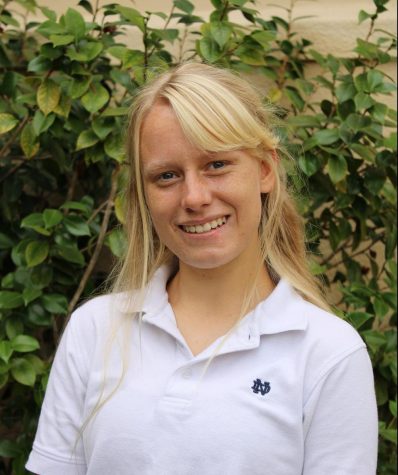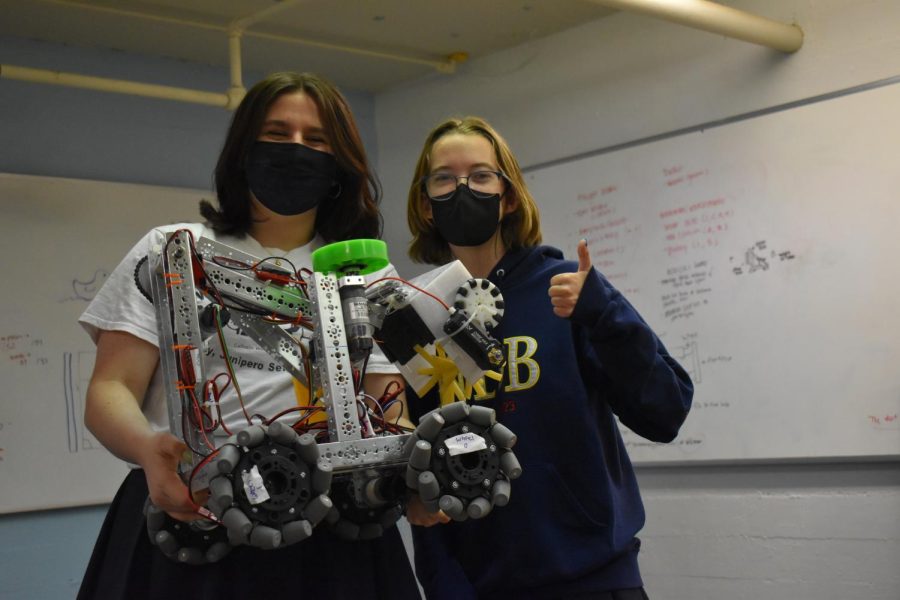An inside look at NDB’s award-winning TigerBots team
The Catalyst / Clair Sapilewski
Build team members Ava Lough Morgan Stein are proud of this year’s competition robot.
A few times a week, a dedicated group of students meets to create robots. But the TigerBots do so much more. Their goal is to create an environment where students are free to explore the world of STEM and a community of hard working individuals.
Science teacher Ashley Dierolf is the adviser for the team and attends meetings, although the team is predominantly student-led. NDB seniors and robotics co-captains Ashley Lau and Ava Lough work hard throughout the year to keep the team and its robots working.
TigerBots began in 2013, after breaking off from the tri-school robotics team at Serra. The NDB team wanted more autonomy over decisions, and felt pushed to the side by the other schools. Now TigerBots has found its own success, having been to both national and international competitions. TigerBots competes in the FIRST (For Inspiration and Recognition of Science and Technology) Robotics Competition, a yearly robotics building challenge and contest for high schools throughout the country. NDB competes in the Northern California FTC (First Tech Challenge), where they face other local schools.
In order to compete, the team must design and build a robot that can complete the tasks and meets the requirements put forth by the league. These specifications change each year. This year’s assignment was called “Freight Frenzy”. The robot they built lifted wiffle balls and plastic blocks onto a tipping tray and moved a horizontal spinning wheel until a rubber duck dropped on the ground.
Each year in September, FTC releases the guidelines and rules for the game on a day called “Kickoff”. After Kickoff, the Build team gets to work.
“The competition is like a game,” Lau said. “We have to build a robot that can complete a certain amount of tasks in a certain order.”
The yearly preparation for the season begins in the summer, when the team begins recruiting students. The team comprises two groups: Business and Build. Business raises money and Build programs and creates the robot. Business begins reaching out to local companies who might be interested in supporting the team around August.
“We’re also completely independently funded,” explains Business lead Lau. “So we got to get our grants in, and that means going around to different companies that sponsor FTC teams and asking.”
This means that the team raises the money required to build the robot on their own. TigerBots must raise around $10,000 during years when they stay at the regional level, and up to $30,000 in years where they make it to the national competition.
The robotics team also helps educate younger children interested in engineering by working with Girl Scouts.
“It’s about teaching young girls about robotics and getting them interested in STEM using Legos,” said junior and Business team member Morgan Stein “The Girl Scouts come in, and we teach them about the different parts of the robot and then they design and build their own robot using Legos.”
The team currently has 10 members, most of which are part of the Business team. In order to win competitions and keep the program alive, TigerBots needs more students interested in programming, electronics and building the robot itself.
“We’re mostly upperclassmen. It’s like, officially, there are 10 people on our team,” Lau said. “We’re struggling right now.”
TigerBots has made getting involved with building robots easy. The team does not require members to have any prior experience, and upperclassmen like Lough, Stein, and Lau are happy to teach newcomers the basics.
“Join robotics because it’s a really fun experience learning how to build robots, the process of having nothing to have a fully functioning robot that you can use to compete, as well as the friends that you make,” said Stein.

Clair Sapilewski is the Managing Editor and is in Journalism II this year. This is her third year writing articles for The NDB Catalyst.
She...

